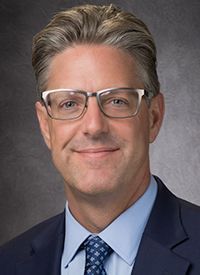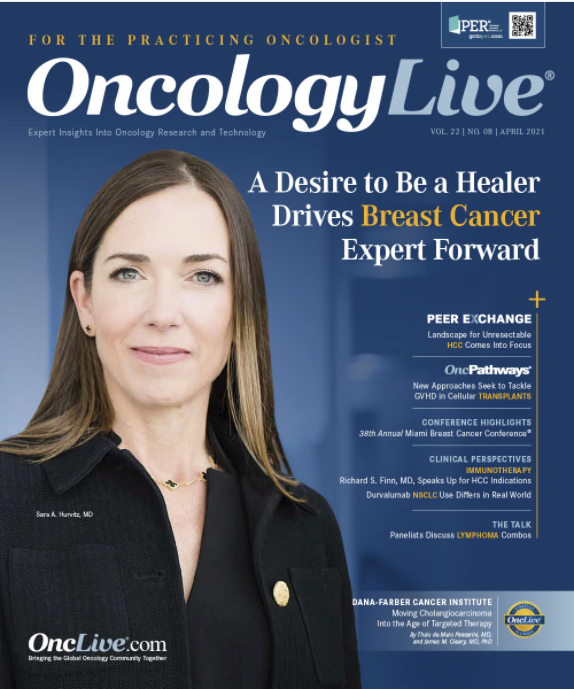Publication
Article
Oncology Live®
Phase 1/2 Studies Set the Stage for Targeted Combos in B-Cell Lymphomas
Author(s):
Although chemotherapy is not likely to lose its place in the frontline treatment of patients with B-cell lymphomas, encouraging data from early-phase studies evaluating the use of targeted agents in combination with and without chemotherapy are capturing the interest of investigators in the field.
Nathan H. Fowler, MD

Although chemotherapy is not likely to lose its place in the frontline treatment of patients with B-cell lymphomas, encouraging data from early-phase studies evaluating the use of targeted agents in combination with and without chemotherapy are capturing the interest of investigators in the field, according to a panel of hematologic cancer experts.
The addition of rituximab (Rituxan) to the chemotherapy regimen of cyclophosphamide, doxorubicin, vincristine, and prednisone (R-CHOP) in 2002 has been the only modification to standard frontline CHOP since its introduction in the 1970s.1 Meanwhile, several targeted therapies and chimeric antigen receptor (CAR) T-cell therapy have made their way into the treatment landscape over the past 4 years for patients with relapsed or refractory B-cell lymphomas.2 However, an unmet clinical need remains for those who are unfit or ineligible for treatment with standard and novel therapeutics.1
Building on the efficacy seen with R-CHOP, investigator-initiated studies have begun to further modify the long-time standard with the addition of targeted agents such as selinexor (Xpovio) and polatuzumab vedotinpiiq (Polivy), as well as combinations using up to 4 targeted agents. Although these trials are conducted in small study populations, investigators have observed durable responses in patients with B-cell lymphomas, particularly those with diffuse large B-cell lymphoma (DLBCL).
“This is something we’ve been dreaming about for a long time, right?” Nathan H. Fowler, MD, said in a recent OncLive® The Talk program. “In any disease, such as [Hodgkin] and large cell lymphoma [for which] you have a regimen that’s curative, it’s very difficult to move away from chemotherapy without a really good signal that you can get similar outcomes. What we’ve been trying to do, and this is going on in a couple of different places, is design these window trials where we’ll introduce novel regimens for a couple of cycles and then add chemotherapy.”
Sarah Rutherford, MD

Fowler joined other panel members Jennifer A. Woyach, MD; Matthew S. Davids, MD, MMSc; and Sarah Rutherford, MD, to discuss key data from the 62nd American Society of Hematology Annual Meeting and Exposition and the potential impact these studies may have on the future care of patients with B-cell malignancies.
Rutherford: The treatment of patients with diffuse large B-cell lymphoma, especially in the relapsed/refractory setting, has changed so much over the last few years. I remember [approximately] 4 years ago, I did not have a whole lot of new therapies to offer other than clinical trial options. But I’m so excited about all the different available agents that I really need to spend time going through potential reasons to pick one over the other.
There have been 3 new FDA-approved agents over the past year or so for relapsed or refractory DLBCL, not including the CAR T-cell therapies [TIMELINE2].
TIMELINE. Recently Approved Targeted Therapies for B-Cell Lymphomas

One of those drugs is selinexor, an oral XPO1 inhibitor. Essentially, it helps facilitate tumor suppressor proteins to work better. Two studies looked at this drug in combination with chemotherapy: one in the frontline setting in combination with R-CHOP and the second in the second-line setting for patients with relapsed and refractory aggressive B-cell lymphoma.
I wanted to highlight that both of these are phase 1, investigator-initiated studies. They’re smaller than some of the others you’ve heard about, but I do think they show that there’s going to be an ongoing role for chemotherapy, particularly in patients with aggressive lymphomas that are chemotherapy responsive [TABLE3-6].
TABLE. Select Phase 1/2 Combination Trials for B-Cell Lymphoma

It would be really nice to be able to add one of these targeted agents, which, as we all know, has been done over the years and there really hasn’t been a superior combination to R-CHOP alone.
One of the studies, as I mentioned, was selinexor plus R-CHOP. The phase 1 portion actually did include a couple of patients with follicular lymphoma who either had no prior treatment or had received 1 non–anthracycline-containing regimen. Most of the patients had untreated DLBCL.
The trial was a 3 + 3 study design, and patients were given weekly doses of selinexor ongoing during the 6 cycles of R-CHOP. Then they could also go onto maintenance therapy. I believe approximately 12 subjects were enrolled. Investigators reported a very high response rate of 100%, with a 90% complete response [CR] rate.
We do expect these patients to generally have high response rates, but these data seem promising. I don’t believe patients had any dose-level toxicities at the 60-mg dose, and 1 was reported at the 80-mg dose. So they selected the 60-mg dose.
Then we have some other exciting targeted therapies in DLBCL and other diseases to talk about. The next study is one that I led at Cornell and is another investigator study of selinexor in combination with RICE [rituximab, ifosfamide, carboplatin, etoposide] chemotherapy in the second-line setting for patients with relapsed or refractory aggressive B-cell lymphomas. We did have a separate arm for patients with Richter transformation.
Ultimately, only 2 patients received selinexor therapy on that regimen. This was a high-risk patient population, an older group, who tended to have comorbidities. We really tried to get the real-world type patients on this study.
We ran into some issues with neurotoxicity that we think were related to ifosfamide when we dosed selinexor prior to the RICE. As a result, we settled on a dosing schema that involved RICE and then starting selinexor on the days 3, 5, and 7 of that regimen. Patients could go on to a stem cell transplant or CAR T-cell therapy after 2 or more cycles at the discretion of the investigator.
There were dose-limiting toxicities with the 60-mg dose, which was the recommended dose for the phase 2 study. We found that 40 mg of selinexor was the recommended phase 2 dose with this combination. Results showed that a higher overall response rate of approximately 77% was reported in the group that was treated at the maximum tolerated dose, with 4 CRs, 3 PRs [partial responses], and 2 patients with stable disease. This was a promising regimen.
Other studies are ongoing with selinexor in combination with chemotherapy, and I think that those will be exciting to see. Targeted drugs in combination will be the way of the future in DLBCL.
Dr Fowler, do you have anything to add about those or some of the other new combinations?
Fowler: I think it’s interesting that in the phase 2 trial [SADAL] trial [NCT02227251] that led to registration with selinexor, a population of patients had a CR that was really a long, durable CR. It brings up that point that with all these new drugs, there probably is an exquisitely sensitive population that we still don’t understand.
Rutherford: Right. Actually, that reminds me that in our study, we had 3 patients who did not end up getting stem cell transplant. These patients had only 2 cycles of this regimen [RICE plus selinexor], and 2 of them are 4 years out. One of them is approximately 2½ years out, still in CR with no other therapy done after 2 cycles. So I agree with you on that point.
Fowler: It’s great that we’ve got all these new tools, and it’s time to figure out for whom [they are best suited]. They’re probably different for different people.
I just thought it was really cool in the early trials that these little populations seem to just maybe be cured with these kinds of targeted approaches. [Results from trials exploring] polatuzumab vedotin also looked very, very interesting. The agent was approved with bendamustine in relapsed large cell lymphoma.
Again, it’s a fairly early trial, but there were data from a phase 1b/2 trial [NCT02611323] with polatuzumab vedotin plus venetoclax [Venclexta] and rituximab for patients with relapsed large cell lymphoma that may be another triplet that we can use for patients, especially if they haven’t had any [therapy with] CAR T cells. Not a huge study, but these patients had a median of 3 prior lines of therapy, which was quite a bit for relapsed large cell lymphoma. The CR rate is 30%. Again, although this was indolent lymphoma, maybe it doesn’t sound as good, but think about it in a patient with fourth-line large cell lymphoma.
That’s a pretty decent CR rate. The PFS in the entire group was 4.4 months. It did look like a population of patients who had a CR probably is going to have long, durable remissions. But again, I think this is interesting to watch even though these are small numbers with short follow-up. But I’d be interested to see if there’s a tail with some of the CR rates for patients’ curve in folks [for whom] maybe we can really control the disease.
The last one I wanted to comment on, talking about adding novel agents together, was the ViPOR trial [NCT03223610]. I love the title of this thing. It’s combining a whole bunch of these different novel drugs together. ViPOR stands for venetoclax, ibrutinib [Imbruvica], prednisone, obinutuzumab [Gazyva], and lenalidomide [Revlimid].
So we’re taking 4 of the exciting, classed agents in lymphoma—BCL2, BTK [Bruton tyrosine kinase], CD20, and IMiDs [immunomodulatory drugs]—and putting them together for patients with relapsed or refractory large cell lymphomas. The response was pretty good. The overall response rate was 56% with a CR rate of 37%. Again, not too bad, especially in a population of these relapsed large cell lymphomas that generally don’t do that well.
If you look at the waterfall plot, approximately 90% of patients had some reduction in tumor volume, including patients who were refractory to prior chemotherapy. But just as important as efficacy was safety. Even with all of these drugs combined, there were no really concerning adverse events.
Jennifer A. Woyach, MD

Woyach: Drs Fowler and Rutherford, I was just wondering, I think that these combinations of targeted therapies in relapsed large cell are really exciting. Do you see a role for nonchemotherapy combinations in the up-front setting?
Fowler: Yes. The issue is, how do you show that in a clinical trial setting? I think the right approach now is to do these kinds of window trials.
[There is also] CAR T-cell therapy. This approach is actually a reverse window, where we use chemotherapy first and then follow it with immunotherapy. But I think in the short term, it’s going to be hard to use a completely novel regimen in the front line until we’re absolutely sure it’s going to provide similar outcomes.
Rutherford: I think one patient population for which I could foresee [these novel combinations] being used and an early one to study is the older patients. There are some patients who can get CAR T-cell therapy, with data that support giving it to patients who are 80 years or older.
However, I have actually a number of patients who are 90 years or older with DLBCL that I wouldn’t feel comfortable doing a cellular therapy. Sometimes they relapse. We tend to give them R-CHOP in small doses. I have a woman who is in her 90s going through it right now and is doing great.
But I think that that type of person would be one in whom I would like to study some of these targeted agents. They tend to have an ABC [activated B-cell] subtype or nongerminal centered type. I’ve had some patients respond really well to the ibrutinib and lenalidomide and rituximab combination for years, on or off trial.
I’m excited about these combinations for those patients. Even though CAR T-cell therapy is available in this space, I think there’s a role for all the targeted therapies as well.










